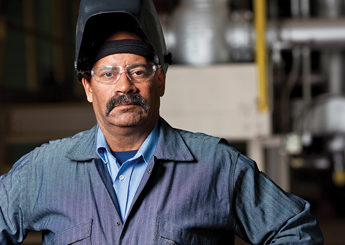La seguridad de los trabajadores latinos
Why are workplace injuries and deaths increasing among Latino employees?

Cultural issues
Culture and communication play a vital role in the safety of Latino workers. For example, when workers don’t understand the language in which instructions are given – or do not understand it well – safety is affected, according to Jose Perez. “If the language barrier is not addressed properly, this at times carries consequences in regards to safety,” said Perez, who is based in California as the corporate safety manager for The Wonderful Company (a health-product manufacturer) and is the chair of the American Society of Safety Engineers’ Safety Professionals and the Latino Workforce group.
Perez immigrated to the United States when he was 19 years old. His first two years in the country were spent working as a farm laborer and then in construction. Since then, he has had a career in safety, concentrating on improving the safety culture among the workforce. His duties include improving communication between employees and supervisors and bridging culture gaps.
To Perez, an individual’s culture plays a key role in decision-making. Among workers in some Hispanic cultures, reporting injuries or safety hazards to a supervisor can be considered inappropriate or an inconvenience.
“This is not something that employers express, but more the manner of how we are brought up within our Hispanic culture,” Perez said. “We are ingrained with the fact that we should not miss work if we become injured; we should take care of it and continue to work.”
Fixing the problem
Some stakeholders believe the first and most important step in reducing injuries and deaths among Latino workers is immigration reform. More than half of Latino workers killed on the job were foreign-born, and providing a legal status to undocumented workers would give them protection to speak up about workplace hazards, they claim.
“Allowing workers to have an immigration status that allows them to feel that they have rights here, it would allow workers to come out of the shadows and feel more encouraged to exercise their rights,” Martinez said.
Without this reform and subsequent protection, employers can use the threat of deportation to prevent workers from exercising their rights to a safe work environment, according to Martinez.
Martinez stressed that not all employers are like this – some actively try to create a safe workplace for employees, including Latinos. But other employers may interpret the law in such a way that favors the employer instead of the worker, or choose not to follow the law or are simply unaware of it.
Education is one of the strongest tools to confront the issue and trend of increasing injuries and fatalities among Latino workers, according to Martinez. Advocacy groups, including National COSH, work to make employees and employers aware of the workplace health and safety protections employers are legally required to provide.
Workers need to know who their employer is – not simply who their supervisor is, but the person who signs the paycheck, Martinez said. They need to know OSHA exists to protect workers, and that the agency’s duty is unaffected by a worker’s immigration status.
However, OSHA is too small to realistically inspect every workplace to ensure employers are taking steps to keep workers safe. Singley Harvey characterized OSHA as “hamstrung by resource shortages.” Although employers are responsible for ensuring a safe work environment, it’s OSHA’s job to make sure employers are fulfilling their end of the bargain. This becomes harder after years of budget cuts, Singley Harvey said.
Workplace fatalities in general have decreased since the enactment of the Occupational Safety and Health Act in 1970, Martinez said, and that’s due to safety laws and an agency enforcing them. A stronger OSHA, with more inspectors and updated standards, could improve safety for all workers.
Perez reiterated the importance of keeping culture in mind to help protect Latino workers. “When an employee understands that reporting an injury or an unsafe condition is not only acceptable but also welcomed, we begin to break down these barriers,” Perez said.
Post a comment to this article
Safety+Health welcomes comments that promote respectful dialogue. Please stay on topic. Comments that contain personal attacks, profanity or abusive language – or those aggressively promoting products or services – will be removed. We reserve the right to determine which comments violate our comment policy. (Anonymous comments are welcome; merely skip the “name” field in the comment box. An email address is required but will not be included with your comment.)

